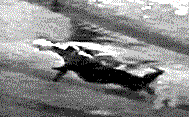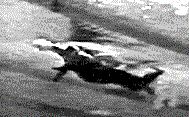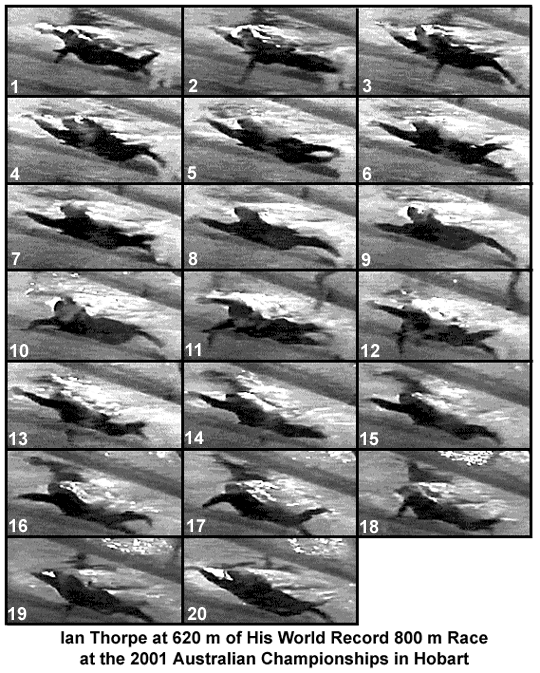HOW CHAMPIONS DO IT
Researched, produced, and prepared by Brent S. Rushall,
Ph.D., R.Psy.

IAN THORPE AT 620 m OF HIS WORLD RECORD 800 m SWIM AT THE 2001 AUSTRALIAN SWIMMING CHAMPIONSHIPS IN HOBART
This stroke analysis includes a moving sequence in real time, a moving sequence where each frame is displayed for .5 of a second, and still frames.
The following image sequence is in real time. It will play through 10 times and then stop. To repeat the sequence, click the browser's "refresh" or "reload" button.

The following image sequence shows each frame for half a second. It will play through 10 times and then stop. To repeat the sequence, click the browser's "refresh" or "reload" button.

At the end of the following narrative, each frame is illustrated in detail in a sequential collage.
Each frame is .1 seconds apart. Ian Thorpe's time for this event was 7:41.59, a new world-record.
This analysis was derived from some very poor video. Thorpe swam in lane 3 and was a considerable distance from the filming camera that was centered on lane 4 (Grant Hackett in this event). The primary purpose of this analysis was to compare Ian Thorpe's stroking pattern to that exhibited in shorter events such as the 200 m.
Other analyses on this web site show the duration of Ian Thorpe's stroke to be 1.5 seconds for 200 m, 1.6 seconds for 400 m, and 1.8 seconds for this 800 m. With increasing distance, the duration of Ian Thorpe's arm stroke cycle increases. The increase in arm cycle time is accompanied by a less vigorous kick, but six movements are still maintained. The relationship of the recovering arm to the pulling arm also changes.
Notable Features
Frame #1: The right arm enters long in front of the swimmer. The left arm is in the first half of its propulsive phase. In 200-m swims, the left arm is markedly further along in the propulsive phase when the right arm enters. The propulsive surface of the arm comprises the hand, forearm, and upper arm at this stage. The left leg begins to kick.
Frame #2: Abduction of the left upper arm drives the forearm/hand propelling surface horizontally and directly. The right arm remains extended forward while the left arm pulls. The right leg begins to kick to assist the hips to roll and to counter-balance any lateral force produced by the left arm action. This kick is not propulsive, but serves to reposition the body.
Frame #3: The left elbow begins to extend as adduction nears completion. A deep kick with the left leg causes the hip to rotate (upward) in the opposite direction as a reaction to the force created by the kick. The left shoulder also begins to rotate upward, which assists clearing the left arm in the initial stage of recovery. The right arm remains extended forward. The head begins to turn to breathe to the left.
Frame #4: The left arm exits. The left leg recovers. The right leg prepares to kick to counter-balance the vertical force component created by the exiting left arm. The head turns further to breathe to the swimmer's left.
Frame #5: The right arm remains extended forward and produces an inertial lag in the stroke. Ideally, the right arm would at least begin a repositioning movement to achieve a position where propulsion could be generated. The head is fully turned.
Frame #6: The right arm still lags forward as inhalation occurs. Downward pressure begins to be exerted on the right arm. Part of that pressure is to counter-balance the vertical force created by the recovering left arm. The left leg completes its kick and the right leg prepares to kick.
Frame #7: There is minor movement in the right shoulder. The swimmer appears to be "leaning" on the right arm. One purpose of this action is to counter-balance the left arm recovery. The left foot drags to counter-balance the rotational force created by leaning on the right arm [which develops a primarily vertical force]. The right leg begins to kick
Frame #8: The extended right arm is pressed directly downward. The right leg continues a deep kick. That kick helps to maintain the body position on its side while the left arm recovers and the right arm is abducted. At this stage of recovery, the left arm is slightly past the highest position. Inhalation is complete.
Frame #9: The right arm begins to reposition to a propulsive posture (elbow flexion and medial rotation of the upper arm occur). The head returns while left-arm recovery extends forward over the water. The left leg is still "supporting" the swimmer's body position.
Frame #10: Abduction of the upper right arm occurs as further flexion at the elbow is achieved. The left arm is just about to enter partially flexed. The right leg begins to kick and assist the hips to rotate quickly in the other direction. The head is almost fully returned but it looks forward rather than down. The large drag resistance pocket streaming off the face shows the detrimental effect of looking-forward head position.
Frame #11: The left arm enters bent. The right arm is abducted to a wide position. That movement creates a considerable lateral force, which is counter-balanced by the right leg kicking. Kicks that do not counter-balance entry or exit vertical forces produced by the arms mainly serve a steering function, as is the case here. The head is still oriented forward producing excessive drag (evidenced by the extensive gray "beard" of turbulence coming off the chin).
Frame #12: The left arm and shoulder extend forward. The right arm has passed its widest position and is adducting. The left leg continues to "steer", being held down to act as a rudder. The left leg prepares to kick.
Frame #13: The right arm continues propulsion through elbow extension and is positioned next to the hip. The left arm still "waits" forward. The left leg prepares to kick to counter-balance the soon-to-exit right arm.
Frame #14: The right arm rounds-out as part of the exit movement. The swimmer is streamlined very well.
Frame #15: The left leg kicks as the right arm moves vertically on exit. The left arm appears to initiate movement as it starts to reposition for propulsion. The right leg is positioned to kick.
Frame #16: The left arm begins to flex noticeably at the elbow as the upper arm medially rotates. The right leg kicks to counter-balance the vertical forces created by the left arm's repositioning movement.
Frame #17: The left upper arm begins to abduct. The positioning of the hand/forearm-propelling surface proceeds. The right leg kick is completed as most of the left arm movements now have very little vertical force component. The left leg prepares to kick. The right arm is still recovering.
Frame #18: The left arm exhibits a classic "elbow-up" position. At this stage, even the upper arm produces some effective propelling surface. Abduction is the power source for the left arm. As the arm rotates outward in the shoulder joint, the left leg moves down to perform a steering function to counter-balance the lateral forces created by the propelling arm.
Frame #19: The right arm enters, as the left arm is more than halfway through the propelling phase. The timing of this stroke is markedly different to that exhibited in Frame #1 but similar to the technique demonstrated in 200-m swims. [This is a feature of distance swimming. Because of fatigue and the longer stroke cycle, more variations of movement patterns occur. Perhaps this sequence illustrates the changeover from one pattern to another.]
Frame #20: The stroke continues to match the position of Frame #4.

Return to Table of Contents for this section.






